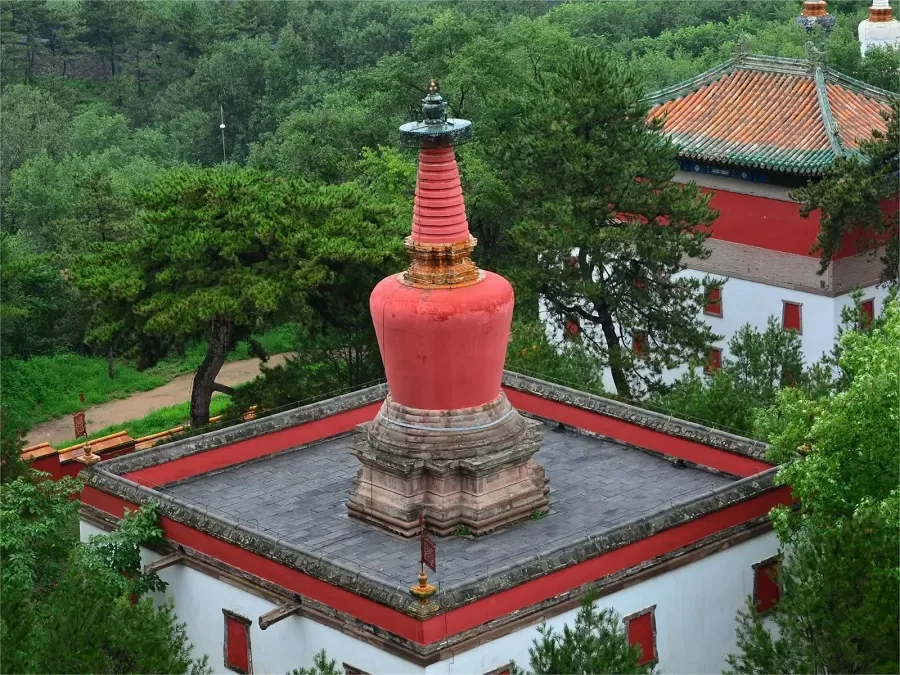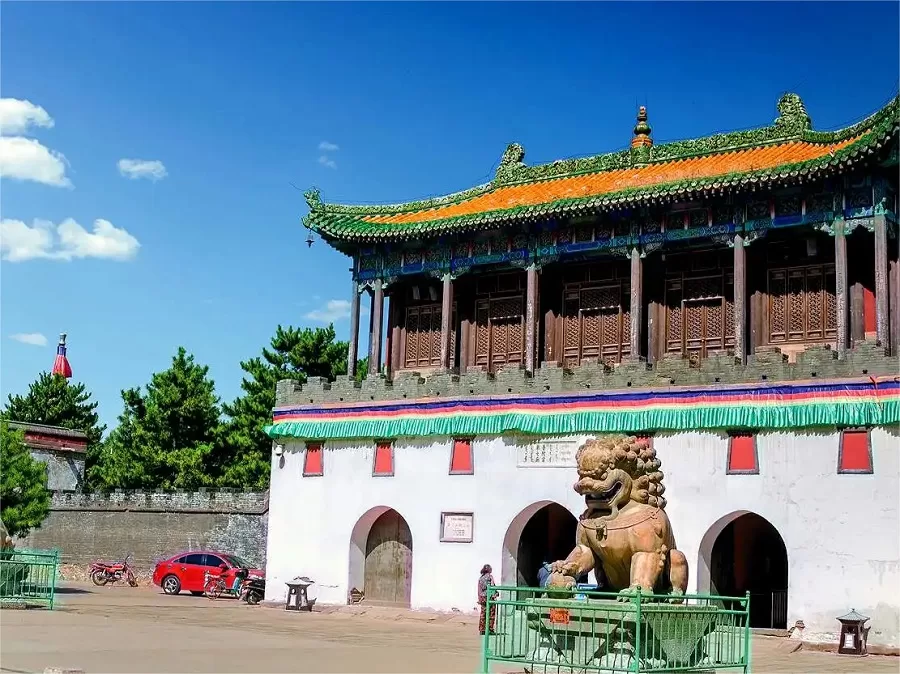Putuo Zongcheng Temple (普陀宗乘之庙) is a magnificent Buddhist temple located on the northern slope of Shizi Gou, to the north of the Chengde Mountain Resort in Chengde City, Hebei Province, China. Its construction began in 1767 and was completed in 1771. The temple holds significant historical and cultural value as it was built by Emperor Qianlong to celebrate his 60th birthday and his mother’s 80th birthday. Among the Eight Outer Temples in Chengde, Putuo Zongcheng Temple stands out for its grandeur and size.
The name “Putuo Zongcheng” is a transliteration of the Tibetan term “Potala,” and the temple was designed in imitation of the Potala Palace, giving it the nickname “Little Potala Palace” among the locals.
Rather than just a temple, Putuo Zongcheng Temple resembles a fortress. The entire structure is built into the natural landscape, rising in layers with a majestic and grandiose presence. The temple is divided into three main sections: the front part includes the mountain gate, stele pavilion, and Five Pagoda Gate; the middle part comprises the glazed archway, white platform, and monk’s quarters; and the rear section features the main red terrace, which is the focal point of the temple.
Table of Contents
- Basic Information
- Location and Transportation
- Why was the Temple Built
- Highlights of Putuo Zongcheng Temple
- Vlog about Putuo Zongcheng Temple
- Useful Tips Summarized from Reviews
- Attractions near Putuo Zongcheng Temple
Basic Information
| Estimated Length of Tour | 2 hours |
| Ticket Price | 80 RMB (1st April – 31st October) 60 RMB (1st November – 31st March) |
| Opening Hours | 8.00 – 18.00; Last admission: 17.10 (1st May – 9th October) 8.30 – 17.00; Last admission: 16.10 (10th October – 31st March the next year) |
| Telephone Number | 0086-0314-2163072 |
Location and Transportation
Putuo Zongcheng Temple is nestled amidst the picturesque landscapes of Chengde, a historic city located in the northeastern part of Hebei Province, China. The temple complex is situated opposite to Chengde Mountain Resort, an expansive imperial garden and palace complex that served as a summer retreat for the Qing dynasty emperors.
To get to the temple, tourists from other cities can first take a high-speed train to Chengde Railway Station and then transfer to a bus (No. 2, 5, or 15) or taxi to cover the remaining 3 kilometers.
Why was the Temple Built
Putuo Zongcheng Temple was built for multiple reasons, primarily to serve as a tribute to and emulation of the Potala Palace in Lhasa, Tibet, which held great religious and political significance for the Qing emperors. Here are some of the key reasons behind the construction of Putuo Zongcheng Temple:
- Imperial Devotion to Tibetan Buddhism: The Qing dynasty rulers sought to consolidate their authority over Tibet and demonstrate their patronage of Tibetan Buddhism. By constructing a temple resembling the Potala Palace, the Qing emperors aimed to reinforce their connection with Tibetan religious leaders and strengthen their influence in the region.
- Political Symbolism: Putuo Zongcheng Temple served as a manifestation of the Qing rulers’ commitment to maintaining harmony between various ethnic and religious groups within their vast empire. It was intended to symbolize the unity of Han Chinese and Tibetan cultures under the Qing rule.
- Religious Pilgrimage Site: The temple complex was also designed to function as a site of pilgrimage for Tibetan Buddhists and followers of the Gelug school of Tibetan Buddhism. It provided a location for religious ceremonies, rituals, and the veneration of sacred relics.
- Cultural Diplomacy: The construction of Putuo Zongcheng Temple was part of the Qing dynasty’s efforts to establish friendly relations with neighboring countries, particularly Tibet and Mongolia. The temple’s architecture and religious significance served as a form of cultural diplomacy, showcasing the Qing rulers’ appreciation for Tibetan culture and faith.
- Recreation of Spiritual Environments: The Qing emperors, who were not able to visit the actual Potala Palace in Tibet, aimed to recreate the spiritual ambiance of that revered place in their own imperial retreat in Chengde. Putuo Zongcheng Temple was a means to transport the essence of Tibetan Buddhist spirituality to a more accessible location.
Highlights of Putuo Zongcheng Temple
Grand Red Terrace

The Red Terrace, situated at the highest point of Putuo Zongcheng Temple, covers an area of 10,300 square meters. The clever use of the terrain connects various buildings into a cohesive whole, creating a visually exaggerated and massive structure. The base of the Red Terrace is the solid white platform, standing 17 meters tall, constructed with granite at the bottom and bricks at the top. Stone steps on the east and west sides lead to the top of the white platform. On the south face of the Red Terrace, six vertically arranged lapis lazuli Buddha niches are adorned, serving as both axis markers and decorative elements. The interior of the Red Terrace consists of three-story attic buildings from the fifth to seventh layers, with a total of 44 rooms on each floor, surrounded on all sides, also known as the group building.
Wanfaguiyi Hall

The main hall within the Red Terrace is the Wafaguaiyi Hall, a square seven-bay hall with slightly recessed corners, featuring a double-eaved roof with corner spires covered in gilded fish-scale copper tiles. The ridges of the four roofs are adorned with wave-patterned gilded tiles, and the top is crowned with a Tibetan-style pagoda pinnacle. The hall’s roof is covered with over 14,000 taels of top-grade gold leaves. This hall served as a place of worship for Qing Dynasty emperors and leaders of various ethnic minorities. At the entrance stands a copper enamel Bodhi stupa, and in the center of the stupa is an ebony flower-shaped Buddha niche housing the Maitreya Buddha. On the east and west sides are ebony longevity character stupas. The offering table in front of the stupa features items such as five offerings, eight treasures, and coral trees, all original to the hall.
White Platform Group

The White Platform Group consists of over 30 surviving Tibetan-style flat-topped tower-style buildings, distributed on both sides of the road from the stele pavilion to the Red Terrace. These towers range from one to four stories high, with two or three stories being the most common. The White Platform buildings mostly adopt a Han-style brick and concrete structural method, with white plaster and green bricks on the edges. The external walls are adorned with red windows. The White Platforms are categorized as hall platforms, tower platforms, open platforms, and solid platforms, each serving different functions and featuring different structures. Some serve as courtyards for monk’s quarters, while others house Han-style halls used as Buddhist halls and bell towers. Some White Platforms have stupas on their roofs, with single or double stupas. There are also solid White Platforms serving as decorative elements.
Mountain Gate

The mountain gate of Putuo Zongcheng Temple faces south and is a combination of Qing and Tibetan architectural styles. Above the Tibetan-style triple gate is a Qing-style city gate tower. The tower is five bays wide and two bays deep, housing guardian deities from left to right: the Four-faced Guardian, Zhanggulu Peng Guardian, and Mahakala Guardian. A pair of stone lions stands in front of the mountain gate.
Vlog about Putuo Zongcheng Temple
Useful Tips Summarized from Reviews
Location and Accessibility: Putuo Zongcheng Temple is located 3 kilometers from the Bishu Shanzhuang (Chengde Mountain Resort), 1.5 kilometers from Chengde Museum, and 19 kilometers from Shuangta Mountain.
Footwear and Terrain: The temple is built on a mountainside with numerous steps, so it’s advisable to wear comfortable shoes. Due to the terrain, it’s not recommended to bring a baby stroller for touring.
Optimal Visit Time: Strongly recommend entering the temple early, around 8:00 AM. From 8:00 to 10:00 AM, there are fewer visitors, and the lighting is softer, providing excellent photo opportunities.
Bring Your Own Beverages: Prices for beverages inside the temple area are significantly higher, so it’s suggested to bring your own.
Parking Facilities: There is a large parking lot right at the entrance.
Ticket Information: The joint ticket for Putuo Zongcheng Temple and Xumi Fushou Temple includes a free shuttle bus service between the two attractions.
Local Specialty Foods: Recommended local delicacies include:





